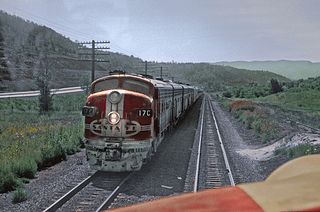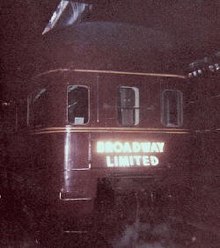
The California Zephyr was a passenger train that ran between Chicago, Illinois and Oakland, California via Omaha, Denver, Salt Lake City, Winnemucca, Oroville and Pleasanton. It was operated by the Chicago, Burlington & Quincy (CB&Q), Denver & Rio Grande Western (D&RGW) and Western Pacific (WP) railroads, all of which dubbed it "the most talked about train in America" on March 19, 1949, with the first departure the following day. The train was scheduled to pass through the most spectacular scenery on its route in the daylight. The original train ceased operation in 1970, though the D&RGW continued to operate its own passenger service, the Rio Grande Zephyr, between Salt Lake City and Denver, using the original equipment until 1983. In 1983 a second iteration of the California Zephyr, an Amtrak service, was formed. The current version of the California Zephyr operates partially over the route of the original Zephyr and partially over the route of its former rival, the City of San Francisco.

The Broadway Limited was a passenger train operated by the Pennsylvania Railroad (PRR) between New York City and Chicago. It operated from 1912 to 1995. It was the Pennsylvania's premier train, competing directly with the New York Central Railroad's 20th Century Limited. The Broadway Limited continued operating after the formation of Penn Central (PC) in February 1968, one of the few long-distance trains to do so. PC conveyed the train to Amtrak in 1971, who operated it until 1995. The train's name referred not to Broadway in Manhattan, but rather to the "broad way" of PRR's four-track right-of-way along the majority of its route.

The Super Chief was one of the named passenger trains and the flagship of the Atchison, Topeka and Santa Fe Railway. The streamliner claimed to be "The Train of the Stars" because of the various celebrities it carried between Chicago, Illinois, and Los Angeles, California.

The 20th Century Limited was an express passenger train on the New York Central Railroad (NYC) from 1902 to 1967. The train traveled between Grand Central Terminal in New York City and LaSalle Street Station in Chicago, Illinois, along the railroad's "Water Level Route".

The City of Denver was a streamlined passenger train operated by the Union Pacific Railroad between Chicago, Illinois, and Denver, Colorado. It operated between 1936 and 1971. From 1936–1955 the Chicago and North Western Railway handled the train east of Omaha, Nebraska; the Chicago, Milwaukee, St. Paul and Pacific Railroad handled it thereafter. The train was the fastest long-distance train in the United States when it debuted in 1936, covering 1,048 miles (1,687 km) in 16 hours. For almost its entire career its principal competitor was the Chicago, Burlington and Quincy Railroad's Denver Zephyr. When Amtrak assumed operation of most intercity trains in the United States in 1971, it discontinued the City of Denver, preferring to use the Burlington's route between Chicago and Denver.

The El Capitan was a streamlined passenger train operated by the Atchison, Topeka and Santa Fe Railway between Chicago, Illinois, and Los Angeles, California. It operated from 1938 to 1971; Amtrak retained the name until 1973. The El Capitan was the only all-coach or "chair car" to operate on the Santa Fe main line between Chicago and Los Angeles on the same fast schedule as the railroad's premier all-Pullman Super Chief. It was also the first train to receive the pioneering Hi-Level equipment with which it would become synonymous.

The Chief was a long-distance named passenger train of the Atchison, Topeka and Santa Fe Railway that ran between Chicago, Illinois and Los Angeles, California. The Santa Fe initiated the Chief in 1926 to supplement the California Limited. In 1936 the Super Chief was introduced, soon eclipsing the Chief as the standard bearer of the Santa Fe. The Chief was discontinued in 1968 due to high operating costs, competition from airlines, and the loss of Postal Office contracts.

The California Limited was one of the named passenger trains of the Atchison, Topeka and Santa Fe Railway. It carried train Nos. 3 & 4 and ran between Chicago, Illinois and Los Angeles, California.

The City of San Francisco was a streamlined through passenger train which ran from 1936 to 1971 on the Overland Route between Chicago, Illinois and Oakland, California, with a ferry connection on to San Francisco. It was owned and operated jointly by the Chicago and North Western Railway (1936–55), Chicago, Milwaukee, St. Paul and Pacific Railroad (1955–71), the Union Pacific Railroad, and the Southern Pacific Railroad. It provided premium extra fare service from Chicago to San Francisco when introduced in 1936 with a running time of 39 hours and 45 minutes each way.

The Columbian was a named passenger train operated by the Baltimore and Ohio Railroad. It was the all-coach supplemental train of the all-Pullman Capitol Limited. It operated from 1931 to 1964. The train's initial route was between Jersey City, New Jersey and Washington, D.C., but in 1941 the Columbian route was lengthened to Jersey City – Chicago, Illinois. It was the first air-conditioned train in the United States.

The Rocky Mountain Rocket was a streamlined passenger train of the Chicago, Rock Island and Pacific Railroad. Rock Island's train numbers 7 and 8 ran between Chicago's LaSalle Street Station and Denver's Union Station and Colorado Springs, Colorado. The Rocky Mountain Rocket ran from 1939 to 1966; the train was discontinued prior to the creation of Amtrak in 1971.

The Trail Blazer was a deluxe all-coach train, inaugurated between New York and Chicago via Pittsburgh, Pennsylvania on 17:25 schedule operated by the Pennsylvania Railroad. The trains departed New York City and Chicago every day at 4:30 pm and 3:00 pm, respectively, and arrived at the destination the next morning. The Trail Blazer was one of the first all-coach trains to provide premium services comparable to a Pullman train. The Trail Blazer name was first used in 1927 for the East St. Louis-Pittsburgh preferred freight VL-6.
The General was the Pennsylvania Railroad's (PRR) number two train between New York City and Chicago. Only marginally slower than the Broadway Limited, it had no extra fare. For a time before World War II, the train carried more passengers than the Broadway Limited and had been stealing passengers from the New York Central Railroad's 20th Century Limited.
The Pittsburgher was an overnight limited passenger train operated by the Pennsylvania Railroad between New York City and Pittsburgh, Pennsylvania over the Pennsylvania's Main Line. It operated from 1924 to 1964 and one of the most prestigious trains operated by the Pennsylvania and perhaps the premier train between New York and Pittsburgh.

The Hi-Level was a type of bilevel intercity railroad passenger car used in the United States. Car types included coaches, dining cars, and lounge cars; a sleeping car variant was considered but never produced. Most passenger spaces were on the upper level, which featured a row of windows on both sides. Boarding was on the lower level; passengers climbed up a center stairwell to reach the upper level. Vestibules on the upper level permitted passengers to walk between cars; some coaches had an additional stairwell at one end to allow access to single-level equipment.

The Strata-Domes were a fleet of five streamlined dome cars operated by the Baltimore and Ohio Railroad ("B&O"). The term referred both to a pair of dome cars constructed by Pullman-Standard and three Budd Company domes the B&O acquired from the Chesapeake and Ohio Railway ("C&O"). They were the first dome cars operated in the Eastern United States, following on the success of the Chicago, Burlington and Quincy Railroad's "Vista-Domes" in the west. The cars entered service in 1949 and were all out of regular service by 1981. Several have been preserved.

The Blue Bird was a streamlined passenger train operated by the Wabash Railroad and its successor the Norfolk and Western Railway between Chicago, Illinois, and St. Louis, Missouri. It operated from 1938 to 1971. Beginning in 1950 it was one of the few Wabash passenger trains to carry a dome car and the first dome train in regular operation between the two cities. The train was cut back to Decatur, Illinois, in 1968 and renamed City of Decatur. Amtrak did not retain the City of Decatur, and it made its last run on April 30, 1971.

The Sun Lounges were a fleet of three streamlined sleeper-lounge cars built by Pullman-Standard for the Seaboard Air Line Railroad in 1956. The cars featured a distinctive glazed roof area meant to capture the ambience of a dome car in a lower profile, as tunnels on the East Coast of the United States prevented the use of dome cars there. The Seaboard employed all three Sun Lounges on its flagship Silver Meteor between New York City and Miami, Florida. The cars later saw service with the Seaboard Coast Line Railroad and Amtrak. Two of the three survive in private ownership.

The Erie Limited was a streamlined passenger train operated by the Erie Railroad between Jersey City, New Jersey and Chicago, Illinois via the Southern Tier. It operated from 1929 to 1963. After the merger of the Erie and the Delaware, Lackawanna and Western Railroad (DL&W) in 1960 it was known as the Erie-Lackawanna Limited. Once the premier passenger train on the Erie, repeated service reductions in the 1950s and 1960s left it a shell of its former self. The Phoebe Snow replaced it in 1963.

The Liberty Limited was a named train on the Pennsylvania Railroad. It ran from Washington D.C. to Chicago, Illinois, through Baltimore, Harrisburg and Pittsburgh. It began running on September 27, 1925, as a replacement for the Washington–Broadway Limited, which had been introduced in 1923. It originally was scheduled to complete its route in 19 hours.



















